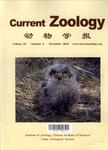Using the *** website to obtain robust phylogenies for avian comparative studies: A primer
Using the *** website to obtain robust phylogenies for avian comparative studies: A primer作者机构:Dipartimento di Bioscienze Universita degli Studi di Milano via Celoria 26 1-20133 Milano Italy Department of Limnology University of Pannonia Pf. 158 H-8201 Veszpr6m Hungary Department of Evolutionary Ecology Estaci6n Biol6gica de Dofiana-CSIC c/Americo Vespucio s/n E-41092 Seville Spain Laboratoire Ecologie Systematique et Evolution UMR 8079 CNRS Universit6 Paris-Sud XI-AgroParisTech Batiment 362 Universit6 Paris-Sud XI F-91405 Orsay Cedex France
出 版 物:《Current Zoology》 (动物学报(英文版))
年 卷 期:2015年第61卷第6期
页 面:959-965页
核心收录:
学科分类:0710[理学-生物学] 07[理学] 08[工学] 080402[工学-测试计量技术及仪器] 0804[工学-仪器科学与技术] 071002[理学-动物学]
基 金:supported by funds from the Spanish government within the frame of the 'Plan Nacional' program
主 题:Birds BirdTree Comparative method PGLM PGLS Phylogenetic uncertainty
摘 要:Comparative studies of trait evolution require accounting for the shared evolutionary history. This is done by includ- ing phylogenetic hypotheses into statistical analyses of species' traits, for which birds often serve as excellent models. The online publication of the most complete molecular phylogeny of extant bird species (***, BirdTree hereafter) now allows evolutionary biologists to rapidly obtain sets of equally plausible phylogenetic trees for any set of species to be incorporated as a phylogenetic hypothesis in comparative analyses. We discuss methods to use BirdTree tree sets for comparative studies, either by building a consensus tree that can be incorporated into standard comparative analyses, or by using tree sets to account for the ef- fect of phylogenetie uncertainty. Methods accounting for phylogenetic uncertainty should be preferred whenever possible because they should provide more reliable parameter estimates and realistic confidence intervals around them. Based on a real compara- tive dataset, we ran simulations to investigate the effect of variation in the size of the random tree sets downloaded from BirdTree on the variability of parameter estimates from a bivariate relationship between mass-specific productivity and body mass. Irre- spective of the method of analysis, using at least 1,000 trees allows obtaining parameter estimates with very small (〈 0.15%) co- efficients of variation. We argue that BirdTree, due to the ease of use and the major advantages over previous 'traditional' meth- ods to obtain phylogenetic hypotheses of bird species (e.g. supertrees or manual coding of published phylogenies), will become the standard reference in avian comparative studies for years to come.



